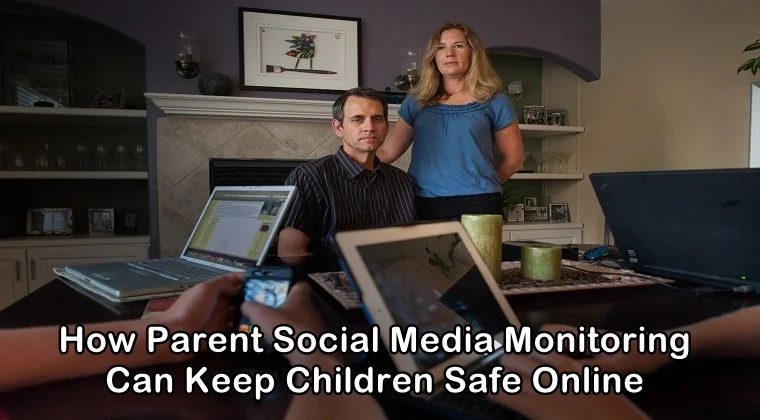How Parent Social Media Monitoring Can Keep Children Safe Online

Children and social media have become inseparable. It would be hard not to find a kid without a smartphone these days. They can explore almost anything just with a single tap on their cellphones. Social media has opened doors to new avenues for them—communicating with their friends, playing games with them, exchanging content with them, etc.
While social media has allowed them to explore all sorts of information and entertainment activities, it has also brought them closer to several online risks. Cyberbullying, sexting, pedophilia, stalking, etc. have become rampant on social media which is why parent social media monitoring has become the need of the hour.
How Parent Social Media Monitoring Works
Parents adopt different ways to ensure their kids are safe in the digital world. The same survey by Pew Research Center also revealed that around 65% of parents have taken their teen’s cellphone or internet privileges as a punishment whereas 55% of them said that they have limited the amount of time or times of day their teens can be online.
Many parents tend to take a hands-on approach when it comes to monitoring their child’s digital use and interactions. They track all the websites their child has visited, monitor their social media profiles, follow them on various social media sites like Facebook, Twitter, and Instagram, and also keep tabs on their phone records and text messages. Some parents even know the password of their child’s social media and email account.
The Use of Technology-Based Tools
Besides adopting different hands-on methods to monitor their child’s digital activity, some parents also use technology-based tools to monitor, block, or track them online. However, the percentage of parents using monitoring tools to track their kids online is relatively less because a) they are not tech-savvy, and b) they are not aware that monitoring tools even exist.
According to a recent survey, it was found out that 39% of parents have used parental controls for monitoring, blocking, and filtering their teen’s digital activities. 16% of them have used parental controls to limit their child’s use of the cellphone. On the other hand, 16% of them have installed monitoring tools on their teen’s mobile phones to track their location.
With the advancement in technology, it has been seen that parents are becoming more aware of the use of parental controls to monitor their kid’s online activity. The awareness of monitoring tools is spreading among the parent’s community gradually. Many parents are now looking up for parental controls on the internet so they can make sure their kids can have a safe online experience.
Monitoring tools like Mobistealth is one great example that helps parents track their kid’s online activity. It is the best social media monitoring software that parents can use. This monitoring tool is compatible with all digital devices including cellphones, computers, and tablets and works on all the platforms including Android, iOS, Windows, and Mac.
As soon as this monitoring tool is installed on the kid’s device, it starts recording every online and offline activity taking place on their device including incoming and outgoing phone calls, text messages, online browsing, and social media activity.
What’s more, this effective monitoring tool helps parents track their child’s real-time location and find out where they actually are. Many parents use the location tracking feature to find out where their kids are and which places they are visiting after school.
Communicate Before You Start Monitoring
We cannot take away the significance of communication in every parent-child relationship. Communication always comes first. In addition to making use of several methods to check up on their child’s online behavior, parents must also adopt a proactive approach to avoid problems by communicating with their child about what is acceptable and unacceptable online behavior.
In fact, Lisa Damour, a psychologist, and author expressed her viewpoint in an article in Times by saying that tracking almost everything your kids do online may not be a good idea. She further stressed the importance of having a strong, working relationship with your children.
She said that no amount of digital monitoring can take the place of strong communication that parents can have with their kids. In order to maintain a strong bond with kids, parents should take their kids into confidence and tell them that they are monitoring their digital activity and keeping tabs on their whereabouts. By doing this, they can understand their kids’ digital behavior in a better way.
Parents can sit down with their kids and teach them how to use social media responsibly and wisely. They should explain to their kids the reason behind monitoring their online activity. They need to make their kids understand that they want them to feel protected on the internet.
When children know that parents are monitoring their social media activity for a good reason, they would not feel offended or violated. For this, parents need to gain their trust first and make them believe they are monitoring their online activity for their safety.
The online world is not a safe place for your kids so make sure you communicate the same to them in a better way. Help them learn how to differentiate between what’s good and what’s bad for them online. Help them identify various online threats and ask them to report immediately as soon as they encounter something inappropriate on the internet.
Parents need to teach their kids how to use social media safely without involving themselves in wrong online behavior. Kids may be exposed to cyberbullying, sexting, stalking, and several other online risks on social media that can have a negative impact on their mental health and development.
However, by providing the right guidance and advice, limiting the use of the internet and installing monitoring tools like Mobistealth, parents can keep their children safe from getting into trouble.








